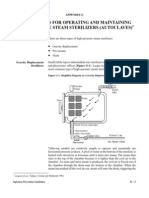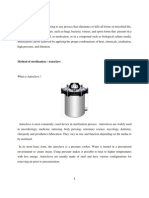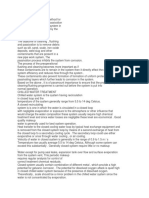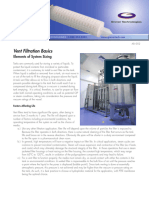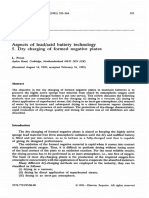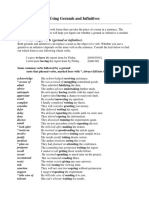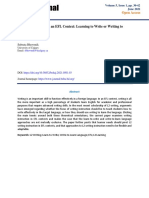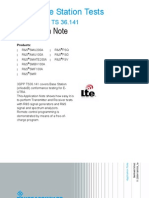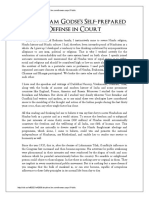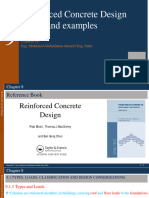SIP Succed at
SIP Succed at
Uploaded by
hugo737977Copyright:
Available Formats
SIP Succed at
SIP Succed at
Uploaded by
hugo737977Original Title
Copyright
Available Formats
Share this document
Did you find this document useful?
Is this content inappropriate?
Copyright:
Available Formats
SIP Succed at
SIP Succed at
Uploaded by
hugo737977Copyright:
Available Formats
Process Engineering | Succeed at steam sterilization | Chemical Processing
Page 1 of 2
SUBMIT QUERY
Succeed at steam sterilization
Follow some dos and donts to keep from making common mistakes.
By William D. Wise, Eli Lilly and Company
Member Login
Become a Member
ChemicalProcessing.com focuses exclusively on serving professionals designing and operating plants in the chemical industry. The unique content helps you make economically competitive as possible.
Since 1978, Ive been designing processes, when I helped develop a successful new pharmaceutical route. Later, I spent five years in a pilot plant which ran more than 100 fermenters. Throughout this time, I have had to grapple with steam sterilization issues and have found that while the principles of steam sterilization are well known, designing actual systems can pose big challenges. Following are some dos and donts gleaned from these experiences, as well as the challenges I still encounter in designing steam-sterilizing systems. Steam sterilization should ensure that organisms do not contaminate plant equipment and products. Unfortunately, design miscues can compromise performance. The effectiveness of sterilization is measured in Fo. [Each Fo represents conditions providing a 90% kill or a one log reduction of normal (D = 1.0) Geobacillus stearothermophilus (also known as Bacillus stearothermophilus) spores. Geobacillus stearothermophilus forms heat resistant spores that are used as a standard for moist-heat sterilization; very heat resistant strains with D = 2 are now available.] For a background bioburden of 1 million Geobacillus stearothermophilus spores, 15 Fos would ensure that there was only one-ina-billion chance of a viable spore surviving. The dos The following seven factors are crucial for successful sterilization. 1. Eliminate air from the system. Effective moist-heat sterilization depends on having saturated steam conditions. When air is present in the system to be sterilized, saturated steam temperature and pressure conditions no longer apply. The air dilutes the steam and a lower temperature than expected is imposed at a given pressure. Trapped pockets of pure air completely prevent steam contact and provide dry-heat sterilization conditions. With saturated steam, one log of kill occurs at 121.1C for one minute. Lower temperature necessitates much longer times to achieve each Fo. Dry-heat sterilization conditions require much higher temperatures and greater time to create one log of kill. Two methods often are used for eliminating air: Pre-vacuum cycles. Autoclaves commonly rely on a vacuum pump to eliminate air from the piping, tubing, equipment, clothing, gauze packing and chamber prior to introducing steam. A cycle of vacuum pull followed by a steam charge is often called a prevac. A series of three prevacs usually suffices to remove air, as long as there are no major leaks. The advantage of prevac cycles is that they can remove air from more-porous materials and potentially deeper deadlegs. The disadvantage is that a vacuum pump has to be purchased and maintained. Steam turbulence and flow. When nothing is present that will trap air, vacuum cycles are unnecessary. Many autoclave loads and most fermenters and piping systems can be sterilized using a gravity cycle. This method depends upon steam flowing throughout the system in a directional way to ensure air is swept out of the system. Steam flows from points of introduction to steam traps, orifices or through valves that allow the air, condensate and steam to leave the system. The piping is designed with minimal pockets or deadlegs to trap air. One technique to eliminate air from a stagnant area is to introduce steam in a way that disrupts the air and then sweeps it out of the system. The most common place to trap air is at a high point that is not vented through a trap or orifice. In fermentation, for instance, it is important to ensure the nozzles at the top of the tank, where the agitator seal and other ports exist, do not trap air. Sending steam in through the nozzle is one method to eliminate air. Designing so that steam flows out through a nozzle to a trap is another. A third method is to introduce steam from another port and point it toward the nozzle suspected of trapping air. The steam will create turbulence and disperse the air. Steam flow through the rest of the system (if designed correctly) will carry the air out. Systems that require sterilization can become pretty complex, especially when piping systems must be included. So, during design, visualizing steam flow and sequencing automatic valves to direct steam flow in defined flow patterns is an important check. Also, choose valves, such as diaphragm ones, that do not have pockets that trap air. The advantage of using steam turbulence and flow is that no vacuum pump is needed. The disadvantage is that more design skill is required to ensure proper flow of steam. 2. Place traps or orifices at low points to drain condensate and slope lines to them. All true low points in a system to be sterilized either should have a steam trap or an orifice to bleed condensate. If not, steam will cool, become condensate that will fall below the required sterilization temperature and thus fail to sterilize the system. The key is to recognize all low points and design in traps or orifices. Also, sloping lines toward the low points allows minimum buildup of condensate and allows it to drain. When using saturated steam, condensate is unavoidable, because it is formed whenever steam condenses to heat an object or surface. The condensate, if it remains at the desired temperature for the desired time, will be sterile. When maintaining the temperature of condensate in a low line poses difficulties, a solution may be to
your sites as efficient, safe, environmentally friendly and
Featured Sponsors Ask the Experts A roster of leading authorities in many fields to help you address technical issues.
http://www.chemicalprocessing.com/articles/2005/592/
3/17/2013
Process Engineering | Succeed at steam sterilization | Chemical Processing
Page 2 of 2
raise the incoming steam pressure to the system and hence the temperature of the low line. The pressure of the steam, the rate at which steam and condensate flow through the orifice or trap, the size and slope of the low line, the amount of insulation and the volume of condensate to be eliminated all play a role in whether that low spot can maintain a given sterilization temperature. 3. Place temperature indicators at low spots and key points. Temperature indicators, usually permanently placed RTDs, provide the process engineer with a way of determining, both in real-time and for after-the-fact troubleshooting, if the system is properly sterilizing during routine production. Traps can fail, valves may remain closed and orifices can plug. Hence, a system that sterilized yesterday could fail today. Placing temperature indicators at each of the low spots where an orifice or trap exists enables detection and automatic alarming when temperature conditions arent met. Adding more instruments boosts costs, but also increases sterility assurance. Temperature elements permanently placed in other key places at the steam source, in the vessel being sterilized or in a location that is a concern also assist in monitoring the sterilization process. 4. Create as leak-free a system as possible. All systems should undergo a leak test prior to and after sterilization. Leaks are bad for several reasons:
Advertise
General Information Advertiser Preview Editorial Calendar
Magazine
Current Issue Issue Archive Meet the Editors
Sister Web Sites
ControlGlobal.com PharmaManufacturing.com PlantServices.com Sustainable Plant Contact Us | Privacy Policy | Legal Disclaimers, Terms & Conditions
Copyright 2004-2013 Chemical Processing. All rights reserved.
http://www.chemicalprocessing.com/articles/2005/592/
3/17/2013
You might also like
- Duct Cleaning PDFDocument4 pagesDuct Cleaning PDFMaazARazaNo ratings yet
- Refrigerant Evacuation_ Don't Be a ClockwatcherDocument6 pagesRefrigerant Evacuation_ Don't Be a ClockwatcherJean-Marie MartineauNo ratings yet
- Appendix G - SteamSterilizers Instruction For Operation and Maintenance of SterilizaersDocument18 pagesAppendix G - SteamSterilizers Instruction For Operation and Maintenance of SterilizaersVishal SharmaNo ratings yet
- Heat Transfer System CleaningDocument4 pagesHeat Transfer System CleaningMicheal BrooksNo ratings yet
- Industrial Ventilation GuidelinesDocument9 pagesIndustrial Ventilation GuidelinesriniNo ratings yet
- Filtration For Aseptic ProcessingDocument4 pagesFiltration For Aseptic Processinghugo737977No ratings yet
- Startup Fluid Analysis: Department Editor: Rebekkah MarshallDocument1 pageStartup Fluid Analysis: Department Editor: Rebekkah MarshallAlejandro AguirreNo ratings yet
- Check List:: With Increased Local and Global Attention Being Given To The Control of AirDocument5 pagesCheck List:: With Increased Local and Global Attention Being Given To The Control of Airskc3128No ratings yet
- Kap8 3Document16 pagesKap8 3Daniela MateiNo ratings yet
- Steam Trap ManualDocument61 pagesSteam Trap Manualbarrysmith77No ratings yet
- Hospitality ServicesDocument12 pagesHospitality Servicesroseenterprises61No ratings yet
- 15 Rules On CondensationDocument4 pages15 Rules On CondensationAnonymous 7CnrWpzZf1No ratings yet
- 4 Cs of Dust Control InformationalDocument5 pages4 Cs of Dust Control Informationalabu_shofiaNo ratings yet
- Vaccum and EvacuationDocument15 pagesVaccum and EvacuationEJ Castro100% (2)
- 15 Rules On CondensationDocument3 pages15 Rules On Condensationsirsa11No ratings yet
- Air Pollution Control Manual BagfilterDocument9 pagesAir Pollution Control Manual BagfilterksbbsNo ratings yet
- 4 Types of Fire Sprinkler SystemsDocument14 pages4 Types of Fire Sprinkler SystemsFayas100% (1)
- Step Guide For HVAC Cleaning This SpringDocument3 pagesStep Guide For HVAC Cleaning This Springwaweruephraim11No ratings yet
- Torch Vacuum Evacuation StartupDocument4 pagesTorch Vacuum Evacuation StartupdustincoleNo ratings yet
- 1-Introduction - OSH AnswersDocument7 pages1-Introduction - OSH AnswersBALASUBRAMANIAN SMNo ratings yet
- Design of Automatic Fire Sprinkler SystemDocument41 pagesDesign of Automatic Fire Sprinkler SystemISH-QUENo ratings yet
- Training Presentation PDFDocument38 pagesTraining Presentation PDFDarko Kocic100% (1)
- AutoclaveDocument8 pagesAutoclaveMohd Azzeeruff HafizNo ratings yet
- Physical IndicatorsDocument3 pagesPhysical IndicatorsDipto Kumer Sarker50% (2)
- How To Validate An Autoclave: Steam Quality TestingDocument4 pagesHow To Validate An Autoclave: Steam Quality TestingGunawanNo ratings yet
- Condenser Operation and Maintenance - 2202 Words - Research Paper ExampleDocument4 pagesCondenser Operation and Maintenance - 2202 Words - Research Paper ExampleAyman FawzyNo ratings yet
- CH 2mmDocument8 pagesCH 2mmAhmed GadNo ratings yet
- Ensuring SterilityDocument10 pagesEnsuring Sterilityjaideep.katareyNo ratings yet
- Flushing MOSDocument7 pagesFlushing MOSarshad iqbal100% (1)
- IndustrialVentilation PresentationDocument61 pagesIndustrialVentilation PresentationAlberto Cruz Velázquez100% (2)
- Industrail VentilationDocument9 pagesIndustrail VentilationBISWARUP BANERJEENo ratings yet
- Steam SterilizerDocument81 pagesSteam Sterilizerkevin. mitnick100% (1)
- Mechanism of Spray DryingDocument10 pagesMechanism of Spray DryingpersonakelabuNo ratings yet
- 609448ac0ff1b06315a80a02 AB002 Vent FilterDocument2 pages609448ac0ff1b06315a80a02 AB002 Vent FilterRahaf AlazzehNo ratings yet
- TT Hydraulic System Care and MaintenanceDocument2 pagesTT Hydraulic System Care and MaintenanceMariglen KurtiNo ratings yet
- Industrial VentilationDocument14 pagesIndustrial VentilationARULSELVAN MURUGESANNo ratings yet
- Equipment and System Dehydrating, Charging, and Testing: Related Commercial ResourcesDocument7 pagesEquipment and System Dehydrating, Charging, and Testing: Related Commercial ResourcesBurning TrainNo ratings yet
- Aspects of Lead Acid Battery Technology 5 Dry Charging of Formed Negative PlatesDocument12 pagesAspects of Lead Acid Battery Technology 5 Dry Charging of Formed Negative PlatestjkiddNo ratings yet
- 9.0 Dust Collection SystemsDocument15 pages9.0 Dust Collection SystemsNol BarandonNo ratings yet
- Pressure TestingDocument27 pagesPressure Testingsaie_1No ratings yet
- Therminol Bulletin1Document4 pagesTherminol Bulletin1anoopsreNo ratings yet
- Steam TrapsDocument5 pagesSteam TrapsAdel Suker100% (2)
- The Evacuation and Charge ProcessDocument3 pagesThe Evacuation and Charge ProcessRyan RobbinsNo ratings yet
- How To Remove Mold in Air HandlersDocument5 pagesHow To Remove Mold in Air HandlersVitaly StotlandNo ratings yet
- Refrigerant Recovery and Recharge of A Room Air Conditioner 170280VDocument9 pagesRefrigerant Recovery and Recharge of A Room Air Conditioner 170280VMathiNo ratings yet
- Pipeline DryingDocument2 pagesPipeline DryingAdan Farias de PinaNo ratings yet
- QUESTION ANSWER-AllDocument35 pagesQUESTION ANSWER-AllVaidushka -ThorNo ratings yet
- Method of Statement For Cleaning Flushing and Passivation of Chilled Water PipingDocument10 pagesMethod of Statement For Cleaning Flushing and Passivation of Chilled Water PipingMYKNo ratings yet
- Steam Sterilization Validation 4Document5 pagesSteam Sterilization Validation 4Pravin GaIkwadNo ratings yet
- Dilution VentilationDocument4 pagesDilution VentilationUthman OpeyemiNo ratings yet
- Removal of Moisture From Systems by Vacuum PumpDocument4 pagesRemoval of Moisture From Systems by Vacuum PumpSaravana KarthikeyanNo ratings yet
- Industrial VentilationDocument53 pagesIndustrial VentilationArindam BhowmickNo ratings yet
- Vacuum ContaminationDocument4 pagesVacuum Contaminationelkin manrique100% (1)
- Manual de Operação Da Série de Coletores de Poeira TK em InglêsDocument24 pagesManual de Operação Da Série de Coletores de Poeira TK em Inglêsfariasodilon91No ratings yet
- Safe Fume Hood Use Guide: FunctionDocument5 pagesSafe Fume Hood Use Guide: FunctionAstrid HerawatiNo ratings yet
- Ventilation: Janmejay Dash M.Tech-CTM 203514001 NIT TrichyDocument23 pagesVentilation: Janmejay Dash M.Tech-CTM 203514001 NIT TrichyJanmejay DashNo ratings yet
- Pipeline DryingDocument2 pagesPipeline DryingAriel Anasco100% (2)
- Ultrasound Analysis for Condition Monitoring: Applications of Ultrasound Detection for Various Industrial EquipmentFrom EverandUltrasound Analysis for Condition Monitoring: Applications of Ultrasound Detection for Various Industrial EquipmentRating: 4.5 out of 5 stars4.5/5 (3)
- Formulaire Canassistance Rempli - Janvier 2018 PDFDocument2 pagesFormulaire Canassistance Rempli - Janvier 2018 PDFhugo737977No ratings yet
- ASME B16.5 Pipe Flanges and Flanged Fittings Published InterpretationsDocument71 pagesASME B16.5 Pipe Flanges and Flanged Fittings Published InterpretationsAymen HileliNo ratings yet
- Embedded Question DrillDocument1 pageEmbedded Question Drillhugo737977No ratings yet
- Revision Code Reference Sheet PDFDocument2 pagesRevision Code Reference Sheet PDFhugo737977No ratings yet
- VPA1 Task3 Company NameDocument1 pageVPA1 Task3 Company Namehugo737977No ratings yet
- Answer Key - GerundsDocument2 pagesAnswer Key - Gerundshugo737977No ratings yet
- Informal ReportsDocument10 pagesInformal Reportshugo737977No ratings yet
- GerundsDocument3 pagesGerundsGabrielaNo ratings yet
- Sight GlassDocument2 pagesSight Glasshugo737977No ratings yet
- 3-A Symbol Holders List - October 20, 2010: 3-A Standard Company Name Auth # City Stateorprovinc CountryDocument29 pages3-A Symbol Holders List - October 20, 2010: 3-A Standard Company Name Auth # City Stateorprovinc Countryhugo737977No ratings yet
- Miller CatalogDocument114 pagesMiller Cataloghugo73797750% (2)
- Sight GlassDocument2 pagesSight Glasshugo737977No ratings yet
- Dakota State University College of Education Lesson Plan FormatDocument6 pagesDakota State University College of Education Lesson Plan Formatapi-568329686No ratings yet
- J2534 Reprogramming User Guide For Version 4.6 and Higher: Updated December 18, 2012Document21 pagesJ2534 Reprogramming User Guide For Version 4.6 and Higher: Updated December 18, 2012totoymola8No ratings yet
- Plan de Lunga Durata La Limba Engleza Pentru Clasa A 5-ADocument24 pagesPlan de Lunga Durata La Limba Engleza Pentru Clasa A 5-AAlexandru Covtun33% (3)
- How To Create Multiple User Login Form in Java Using MySQL Database and NetBeans IDEDocument8 pagesHow To Create Multiple User Login Form in Java Using MySQL Database and NetBeans IDEFranciz CastilloNo ratings yet
- VFD Cable SelectionDocument14 pagesVFD Cable SelectionGerardoBaltaNo ratings yet
- driving_theory_practical_test_uk_highway_code_ebook_pdf_2025Document32 pagesdriving_theory_practical_test_uk_highway_code_ebook_pdf_2025Noeline RazanatsimbaNo ratings yet
- GLSEN 2017 National School Climate SurveyDocument193 pagesGLSEN 2017 National School Climate Surveycorey_c_mitchell100% (1)
- KNORR BREMSE ND Pro DaimlerDocument36 pagesKNORR BREMSE ND Pro DaimlerYoseph GetahunNo ratings yet
- Paper 1 Section B Question-Answer Book BDocument20 pagesPaper 1 Section B Question-Answer Book BKathy WongNo ratings yet
- Attention and ComprehensionDocument22 pagesAttention and ComprehensionABHINAND SNo ratings yet
- Co-Processing of Afr in Euro Cement Industry Cembureau 2009Document16 pagesCo-Processing of Afr in Euro Cement Industry Cembureau 2009Ibnuyusoff77No ratings yet
- Ledger Posting With OE GL UTB SamplesDocument46 pagesLedger Posting With OE GL UTB SamplesZamantha OliverosNo ratings yet
- Membentuk Karakter Bangsa: Sejarah Indonesia Dalam Diorama Monumen NasionalDocument16 pagesMembentuk Karakter Bangsa: Sejarah Indonesia Dalam Diorama Monumen NasionalJokando MalauNo ratings yet
- Data Communications and Networking 3: Dashboard MIS6314 Week 8: Multi-Area OSPF Short Quiz 006Document5 pagesData Communications and Networking 3: Dashboard MIS6314 Week 8: Multi-Area OSPF Short Quiz 006mary annNo ratings yet
- Chap 10Document17 pagesChap 10N.S.RavikumarNo ratings yet
- DLL Week 17Document13 pagesDLL Week 17Junrel flores100% (1)
- Writing Instruction in An EFL Context Learning ToDocument13 pagesWriting Instruction in An EFL Context Learning ToAydelina MedinaNo ratings yet
- Week 1 - Introduction To Consumer Behaviour - TRI 3 2022Document80 pagesWeek 1 - Introduction To Consumer Behaviour - TRI 3 2022Onur SerbestNo ratings yet
- PPPTDocument14 pagesPPPTPrajwal MoreNo ratings yet
- Rhode and Shwartz - LTE - 1MA154 - 1eDocument59 pagesRhode and Shwartz - LTE - 1MA154 - 1edavepurNo ratings yet
- This Study Resource Was: Foreign V. Local ProductsDocument7 pagesThis Study Resource Was: Foreign V. Local ProductsKym DacudaoNo ratings yet
- Strategy For Evangelism and Soul WinningDocument3 pagesStrategy For Evangelism and Soul WinningSam ONi50% (2)
- Nathuram Godse's Self Prepared Defense in CourtDocument5 pagesNathuram Godse's Self Prepared Defense in CourtrossifummiNo ratings yet
- Siglas Usadas em Esquemas EletricosDocument4 pagesSiglas Usadas em Esquemas EletricosRafael MarquesNo ratings yet
- 06 - CONVERSION - Oracle Outbound Interface Process With ExampleDocument8 pages06 - CONVERSION - Oracle Outbound Interface Process With Examplejaish20% (1)
- Motherboard Manual - 6701-Engl v1.0 - Ms-6701Document32 pagesMotherboard Manual - 6701-Engl v1.0 - Ms-6701Athena de GuzmanNo ratings yet
- Water Less DyeingDocument20 pagesWater Less DyeingDhanashree Kudale100% (1)
- TS 2013 Catalog EmailDocument28 pagesTS 2013 Catalog EmailRachel GordonNo ratings yet
- SBI Life - Eshield Insta Ready Reckoner - With GSTDocument2 pagesSBI Life - Eshield Insta Ready Reckoner - With GST9550911087rsNo ratings yet
- Chapter 9AADocument24 pagesChapter 9AAIbraahim AbdiNo ratings yet


